Spatial Constitutive Modeling of AA7050-T7451 with Anisotropic Stress Transformation
Abstract
:1. Introduction
2. Theoretical Research on Anisotropy
2.1. Coordinate-System Conversion Matrix
2.2. Mechanical Properties of the Anisotropy
3. Experimental
3.1. Specimen Preparation
3.2. Experimental Setup and Principle
4. Results and Discussion
4.1. Establishment of a Anisotropic Constitutive Model
4.2. Anisotropic Mechanical Property Analysis of AA7075-T7451
4.3. Modification of the Constitutive Model
4.3.1. Constitutive Model in the Orthogonal Coordinate System
4.3.2. Verification of the Elastic Modulus and Shear Modulus
4.3.3. Modification of the Spatial Constitutive Model
4.3.4. Simulation Modeling of Dynamic Shock Compression Process
5. Conclusions
Author Contributions
Funding
Conflicts of Interest
References
- Komarasamy, M.; Alagarsamy, K.; Ely, L.; Mishra, R.S. Characterization of 3″ through-thickness friction stir welded 7050-T7451 Al alloy. Mater. Sci. Eng. A 2018, 716, 55–62. [Google Scholar] [CrossRef]
- Krishnan, P.K.; Christy, J.V.; Arunachalam, R.; Mourad, A.-H.I.; Muraliraja, R.; Al-Maharbi, M.; Murali, V.; Chandra, M.M. Production of aluminum alloy-based metal matrix composites using scrap aluminum alloy and waste materials: Influence on microstructure and mechanical properties. J. Alloys Compd. 2019, 784, 1047–1061. [Google Scholar] [CrossRef]
- Mishra, S.; Kulkarni, K.; Gurao, N.P. Effect of crystallographic texture on precipitation induced anisotropy in an aluminium magnesium silicon alloy. Mater. Des. 2015, 87, 507–519. [Google Scholar] [CrossRef]
- Bhattacharyya, J.J.; Bittmann, B.; Agnew, S.R. The effect of precipitate-induced backstresses on plastic anisotropy: Demonstrated by modeling the behavior of aluminum alloy, 7085. Int. J. Plast. 2019, 117, 3–20. [Google Scholar] [CrossRef]
- Linul, E.; Movahedi, N.; Marsavina, L. The temperature and anisotropy effect on compressive behavior of cylindrical closed-cell aluminum-alloy foams. J. Alloys Compd. 2018, 740, 1172–1179. [Google Scholar] [CrossRef]
- Safyari, M.; Moshtaghi, M.; Kuramoto, S.; Hojo, T. Influence of microstructure-driven hydrogen distribution on environmental hydrogen embrittlement of an Al–Cu–Mg alloy. Int. J. Hydrog. Energy 2021, 46, 37502–37508. [Google Scholar] [CrossRef]
- Sheikh-Ansari, M.H.; Aghaie-Khafri, M. Constitutive modeling of semisolid deformation for the assessment of dilatant shear bands. Appl. Math. Model. 2019, 70, 128–138. [Google Scholar] [CrossRef]
- Ryś, M.; Egner, H. Energy equivalence based constitutive model of austenitic stainless steel at cryogenic temperatures. Int. J. Solids Struct. 2018, 164, 52–65. [Google Scholar] [CrossRef]
- Abedini, A.; Butcher, C.; Nemcko, M.J.; Kurukuri, S.; Worswick, M.J. Constitutive characterization of a rare-earth magnesium alloy sheet (ZEK100-O) in shear loading: Studies of anisotropy and rate sensitivity. Int. J. Mech. Sci. 2017, 128–129, 54–69. [Google Scholar] [CrossRef]
- Lhadi, S.; Berbenni, S.; Gey, N.; Richeton, T.; Germain, L. Micromechanical modeling of the effect of elastic and plastic anisotropies on the mechanical behavior of β-Ti alloys. Int. J. Plast. 2018, 109, 88–107. [Google Scholar] [CrossRef]
- Borik, M.A.; Borichevskij, V.P.; Bublik, V.T.; Kulebyakin, A.V.; Lomonova, E.E.; Milovich, F.O.; Myzina, V.A.; Ryabochkina, P.A.; Sidorova, N.V.; Tabachkova, N.Y. Anisotropy of the mechanical properties and features of the tetragonal to monoclinic transition in partially stabilized zirconia crystals. J. Alloys Compd. 2019, 792, 1255–1260. [Google Scholar] [CrossRef]
- Marvi-Mashhadi, M.; Lopes, C.S.; Llorca, J. Effect of anisotropy on the mechanical properties of polyurethane foams: An experimental and numerical study. Mech. Mater. 2018, 124, 143–154. [Google Scholar] [CrossRef]
- Plunkett, B.; Cazacu, O.; Barlat, F. Orthotropic yield criteria for description of the anisotropy in tension and compression of sheet metals. Int. J. Plast. 2008, 24, 847–866. [Google Scholar] [CrossRef]
- Cazacu, O. New yield criteria for isotropic and textured metallic materials. Int. J. Solids Struct. 2018, 139–140, 200–210. [Google Scholar] [CrossRef]
- Cardoso, R.P.R.; Adetoro, O.B. A generalisation of the Hill’s quadratic yield function for planar plastic anisotropy to consider loading direction. Int. J. Mech. Sci. 2017, 128–129, 253–268. [Google Scholar] [CrossRef]
- Orlowski, K.A.; Ochrymiuk, T.; Sandak, J.; Sandak, A. Estimation of fracture toughness and shear yield stress of orthotropic materials in cutting with rotating tools. Eng. Fract. Mech. 2017, 178, 433–444. [Google Scholar] [CrossRef]
- Meng, Y.; Wang, X.; Zongcheng, H.; Fu, X. The Influence of Forming Directions and Strain Rate on Dynamic Shear Properties of Aerial Aluminum Alloy. Appl. Sci. 2018, 8, 520. [Google Scholar] [CrossRef]
- Zhang, X.; Liu, Y.; Wei, Y.; Yun, X. Finite element simulation for the punch and stress-strain relationship of anisotropic Aluminum alloy. J. Dalian Jiaotong Univ. 2008, 29, 44–47. [Google Scholar]
- Medjahed, A.; Moula, H.; Zegaoui, A.; Derradji, M.; Henniche, A.; Wu, R.; Hou, L.; Zhang, J.; Zhang, M. Influence of the rolling direction on the microstructure, mechanical, anisotropy and gamma rays shielding properties of an Al-Cu-Li-Mg-X alloy. Mater. Sci. Eng. A 2018, 732, 129–137. [Google Scholar] [CrossRef]
- Liu, Y.; Xu, D.; Xu, J. Updated 5-parameters barlat-lian yield criteria. J. Huazhong Univ. Sci. Technol. 2008, 36, 129–132. [Google Scholar]
- Pilthammar, J.; Sigvant, M.; Kao-Walter, S. Introduction of elastic die deformations in sheet metal forming simulations. Int. J. Solids Struct. 2017, 151, 76–90. [Google Scholar] [CrossRef]
- Feng, B.; Bronkhorst, C.A.; Addessio, F.L.; Morrow, B.M.; Li, W.H.; Lookman, T.; Cerreta, E.K. Coupled nonlinear elasticity, plastic slip, twinning, and phase transformation in single crystal titanium for plate impact loading. J. Mech. Phys. Solids 2019, 127, 358–385. [Google Scholar] [CrossRef]
- Cyr, E.D.; Brahme, A.; Mohammadi, M.; Mishra, R.K.; Inal, K. A new crystal plasticity framework to simulate the large strain behaviour of aluminum alloys at warm temperatures. Mater. Sci. Eng. A 2018, 727, 11–28. [Google Scholar] [CrossRef]
- Tayon, W.A.; Nygren, K.E.; Crooks, R.E.; Pagan, D.C. In-situ study of planar slip in a commercial aluminum-lithium alloy using high energy X-ray diffraction microscopy. Acta Mater. 2019, 173, 231–241. [Google Scholar] [CrossRef]
- Muhammad, W.; Sabat, R.K.; Brahme, A.P.; Kang, J.; Mishra, R.K.; Shalchi-Amirkhiz, B.; Hirsch, J.; Inal, K. Deformation banding in a precipitation hardened aluminum alloy during simple shear deformation. Scr. Mater. 2019, 162, 300–305. [Google Scholar] [CrossRef]
- Kireeva, I.V.; Chumlyakov, Y.I.; Pobedennaya, Z.V.; Vyrodova, A.V.; Kuksgauzen, I.V.; Kuksgauzen, D.A. Orientation and temperature dependence of a planar slip and twinning in single crystals of Al0.3CoCrFeNi high-entropy alloy. Mater. Sci. Eng. A 2018, 737, 47–60. [Google Scholar] [CrossRef]
- Turner, T.J.; Miller, M.P.; Barton, N.R. The influence of crystallographic texture and slip system strength on deformation induced shape changes in AA 7050 thick plate. Mech. Mater. 2002, 34, 605–625. [Google Scholar] [CrossRef]
- Wei, Y.L.; Godfrey, A.; Liu, W.; Liu, Q.; Huang, X.; Hansen, N.; Winther, G. Dislocations, boundaries and slip systems in cube grains of rolled aluminium. Scr. Mater. 2011, 65, 355–358. [Google Scholar] [CrossRef]
- Cantara, A.M.; Zecevic, M.; Eghtesad, A.; Poulin, C.M.; Knezevic, M. Predicting elastic anisotropy of dual-phase steels based on crystal mechanics and microstructure. Int. J. Mech. Sci. 2019, 151, 639–649. [Google Scholar] [CrossRef]
- Gao, K.; Harrison, J.P. Generation of random stress tensors. Int. J. Rock Mech. Min. Sci. 2016, 94, 18–26. [Google Scholar] [CrossRef]
- Biel, A.; Stigh, U. Comparison of J-integral methods to experimentally determine cohesive laws in shear for adhesives. Int. J. Adhes. Adhes. 2019, 94, 64–75. [Google Scholar] [CrossRef]
- Ribeiro, A.B.; Mascia, N.T. Numerical and experimental study of shear stress behavior of NBR and ASTM standard test specimens for FRP-wood bonds. Compos. Struct. 2019, 224, 111066. [Google Scholar] [CrossRef]
- Bruning, T.; Karakus, M.; Nguyen, G.D.; Goodchild, D. An experimental and theoretical stress-strain-damage correlation procedure for constitutive modelling of granite. Int. J. Rock Mech. Min. Sci. 2019, 116, 1–12. [Google Scholar] [CrossRef]
- Yan, B.; Regueiro, R.A. Definition and symmetry of averaged stress tensor in granular media and its 3D DEM inspection under static and dynamic conditions. Int. J. Solids Struct. 2019, 161, 243–266. [Google Scholar] [CrossRef]
- Ndubuaku, O.; Liu, X.; Martens, M.; Cheng, J.J.R.; Adeeb, S. The effect of material stress-strain characteristics on the ultimate stress and critical buckling strain of flat plates subjected to uniform axial compression. Constr. Build. Mater. 2018, 182, 346–359. [Google Scholar] [CrossRef]
- Chandola, N.; Cazacu, O.; Revil-Baudard, B. Prediction of plastic anisotropy of textured polycrystalline sheets using a new single-crystal model. Comptes. Rendus. Méc. 2018, 346, 756–769. [Google Scholar] [CrossRef]
- Saleh, M.; Kariem, M.M.; Luzin, V.; Toppler, K.; Li, H.; Ruan, D. High strain rate deformation of ARMOX 500T and effects on texture development using neutron diffraction techniques and SHPB testing. Mater. Sci. Eng. A 2018, 709, 30–39. [Google Scholar] [CrossRef]
- Pervier, M.L.A.; Lerma, B.G.; Moncholi, E.P.; Hammond, D.W. A new test apparatus to measure the adhesive shear strength of impact ice on titanium 6Al-4V alloy. Eng. Fract. Mech. 2019, 214, 212–222. [Google Scholar] [CrossRef]
- Daryadel, S.S.; Mantena, P.R.; Kim, K.; Stoddard, D.; Rajendran, A.M. Dynamic response of glass under low-velocity impact and high strain-rate SHPB compression loading. J. Non-Cryst. Solids 2015, 432, 432–439. [Google Scholar] [CrossRef]
- Eivani, A.R.; Vafaeenezhad, H.; Nikan, O.; Zhou, J. Modeling high temperature deformation characteristics of AA7020 aluminum alloy using substructure-based constitutive equations and mesh-free approximation method. Mech. Mater. 2019, 129, 104–112. [Google Scholar] [CrossRef]
- Ye, Z.B.; Huang, R.Y.; Li, Y.C.; Lv, L.; Zhao, K.; Zhang, Y.L.; Ma, J.; Lin, J.J. Steel fiber-reinforced concrete under impact loading dynamic constitutive equation. Constr. Build. Mater. 2018, 190, 1049–1055. [Google Scholar] [CrossRef]
- Wang, B.; Liu, Z. Shear localization sensitivity analysis for Johnson–Cook constitutive parameters on serrated chips in high speed machining of Ti6Al4V. Simul. Model. Pract. Theory 2015, 55, 63–76. [Google Scholar] [CrossRef]
- Dhananchezian, M.; Kumar, M.P.; Sornakumar, T. Cryogenic Turning of AISI 304 Stainless Steel with Modified Tungsten Carbide Tool Inserts. Mater. Manuf. Process. 2011, 26, 781–785. [Google Scholar] [CrossRef]
- Luong, H.; Hill, M.R. The effects of laser peening and shot peening on high cycle fatigue in 7050-T7451 aluminum alloy. Mater. Sci. Eng. A 2010, 527, 699–707. [Google Scholar] [CrossRef]
- Mello, A.W.; Nicolas, A.; Lebensohn, R.A.; Sangid, M.D. Effect of microstructure on strain localization in a 7050 aluminum alloy: Comparison of experiments and modeling for various textures. Mater. Sci. Eng. A 2016, 661, 187–197. [Google Scholar] [CrossRef]
- Harzallah, M.; Pottier, T.; Senatore, J.; Mousseigne, M.; Germain, G.; Landon, Y. Numerical and experimental investigations of Ti-6Al-4V chip generation and thermo-mechanical couplings in orthogonal cutting. Int. J. Mech. Sci. 2017, 134, 189–202. [Google Scholar] [CrossRef] [Green Version]
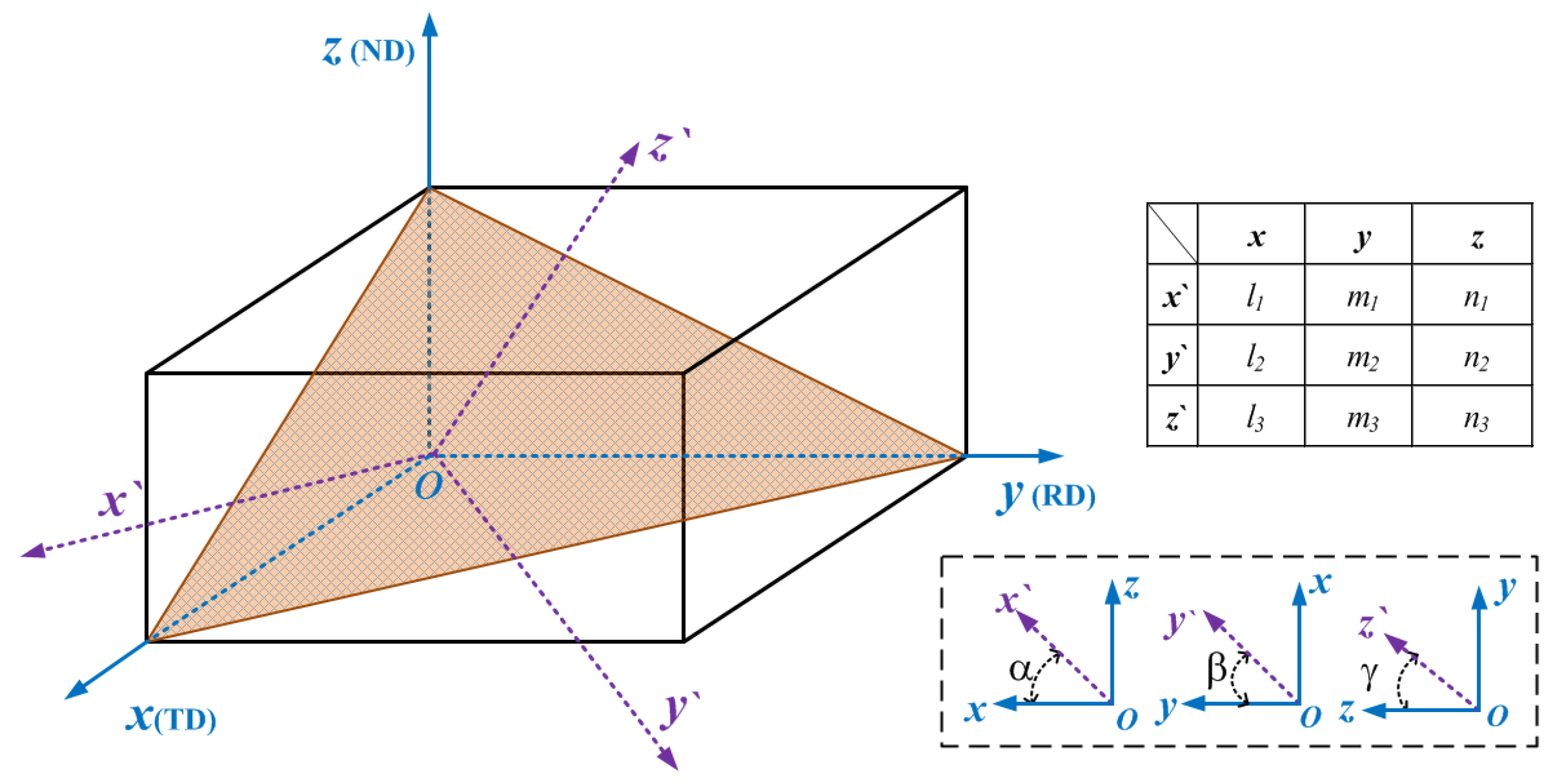
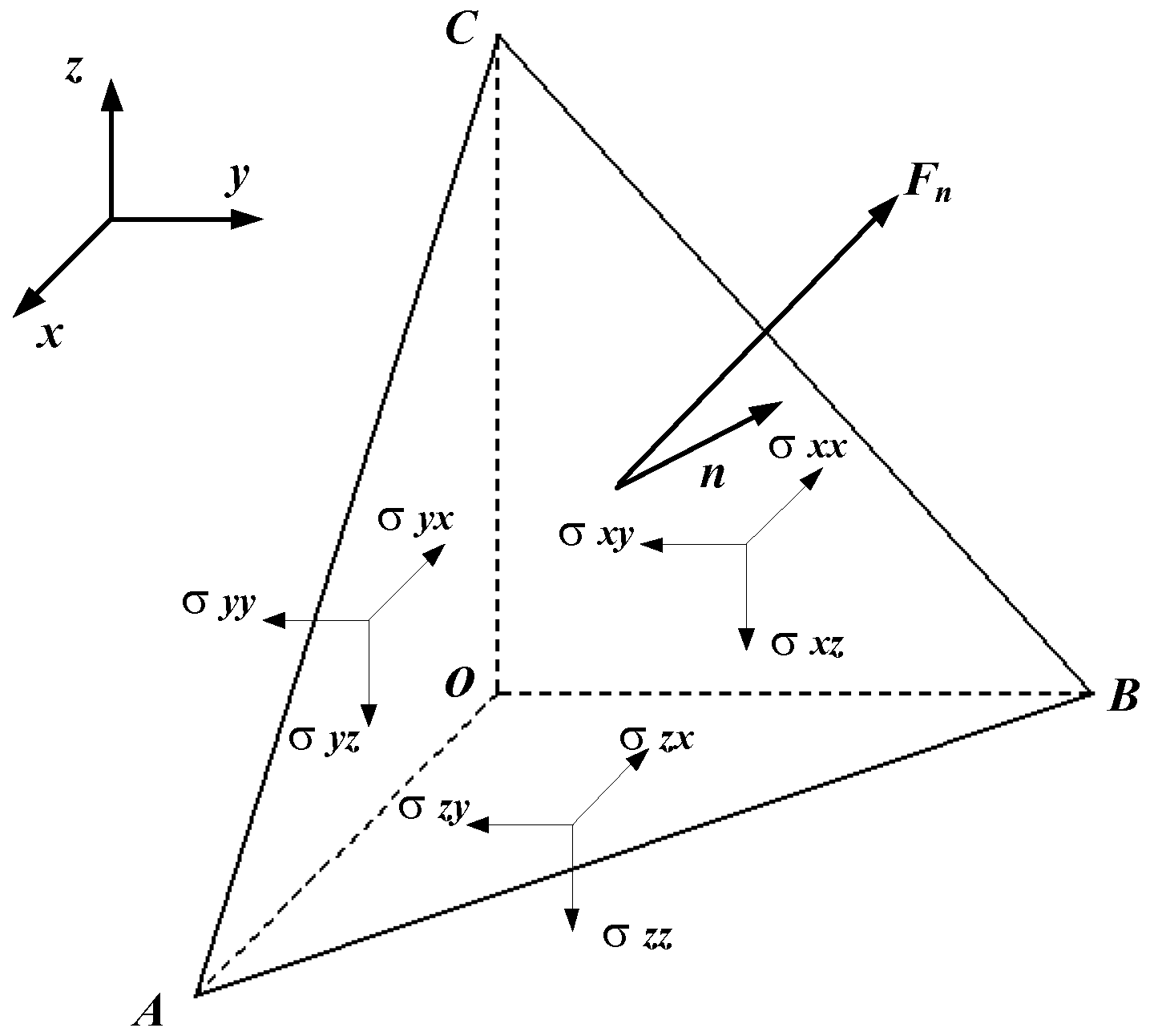
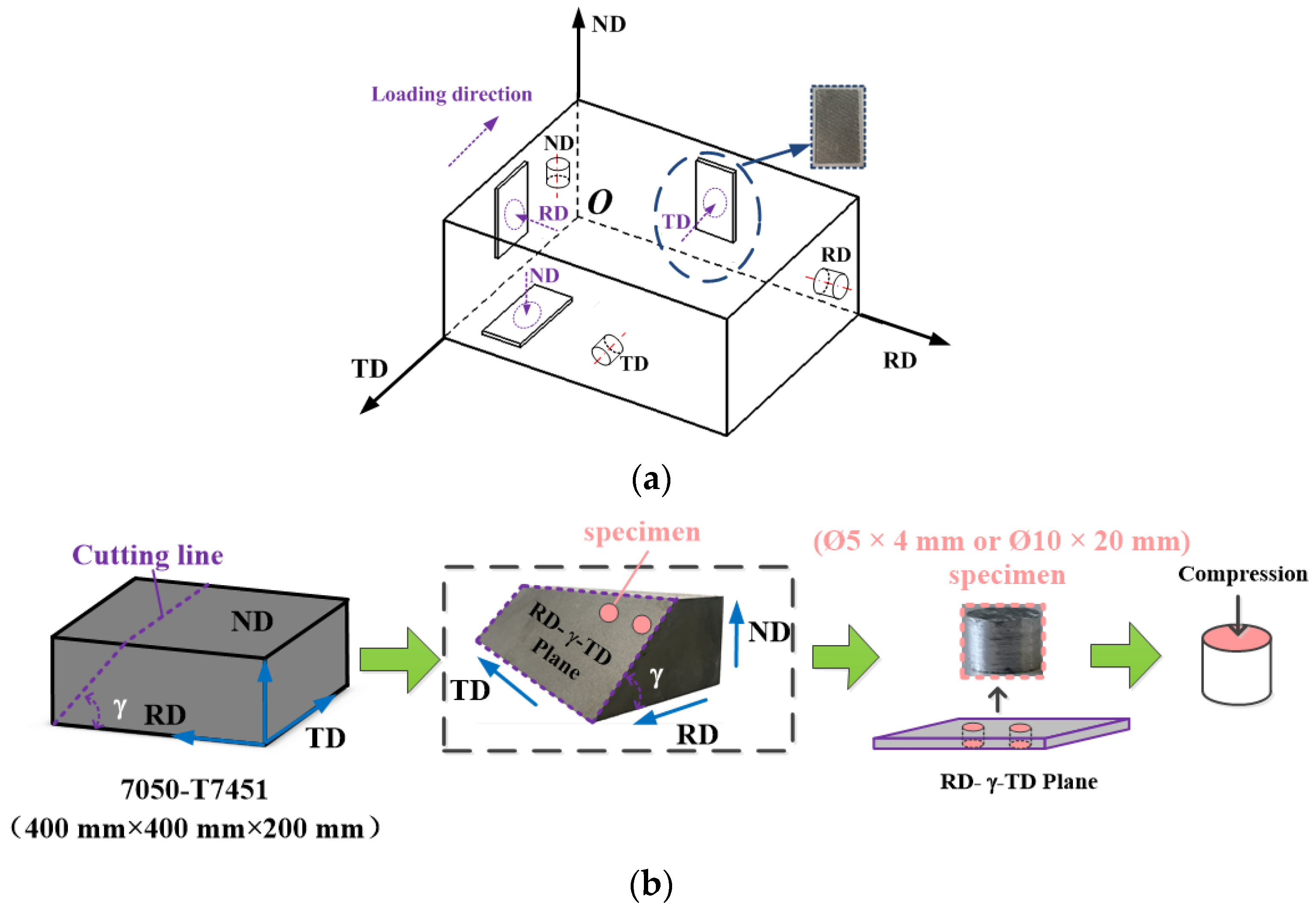
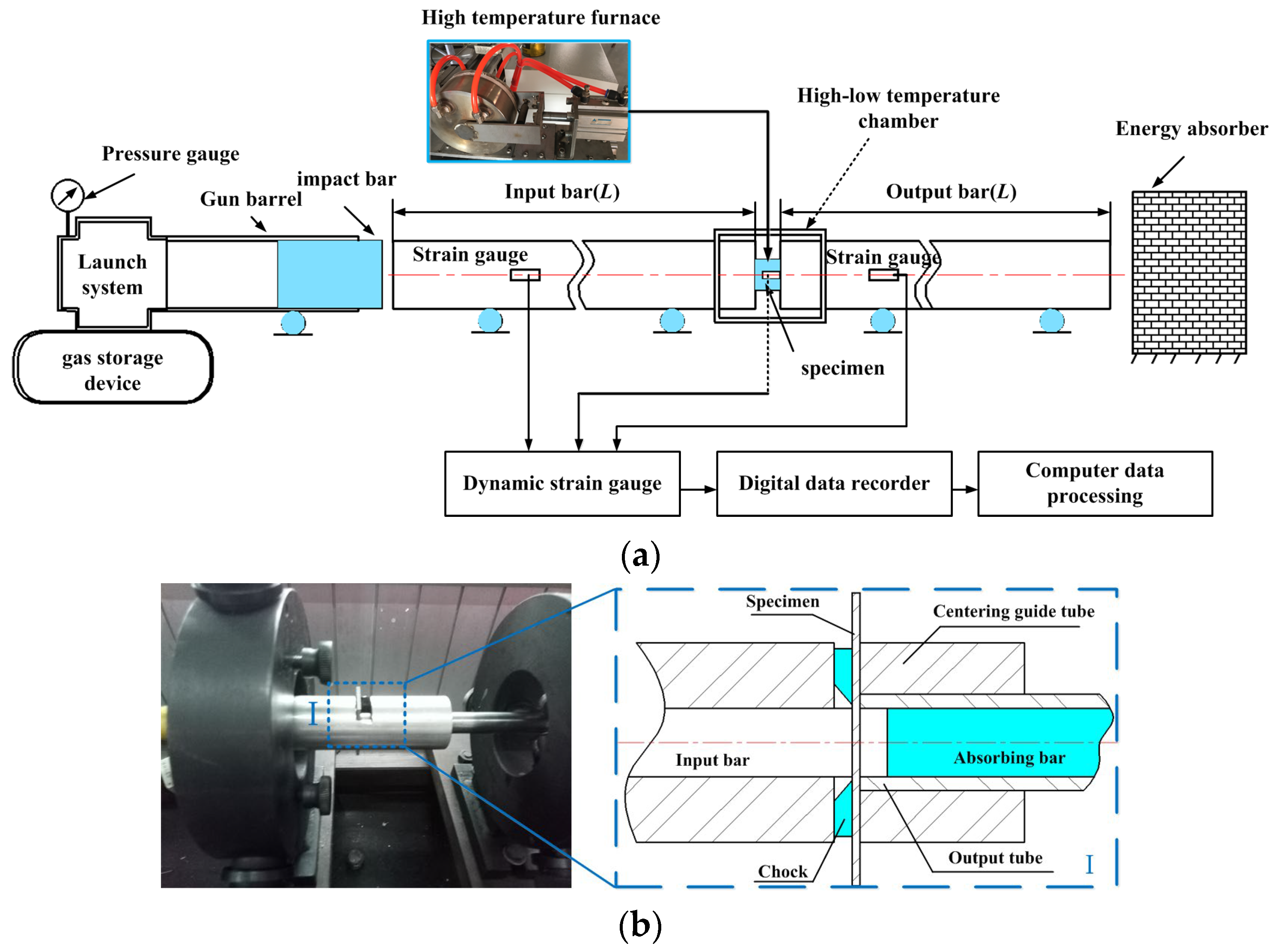
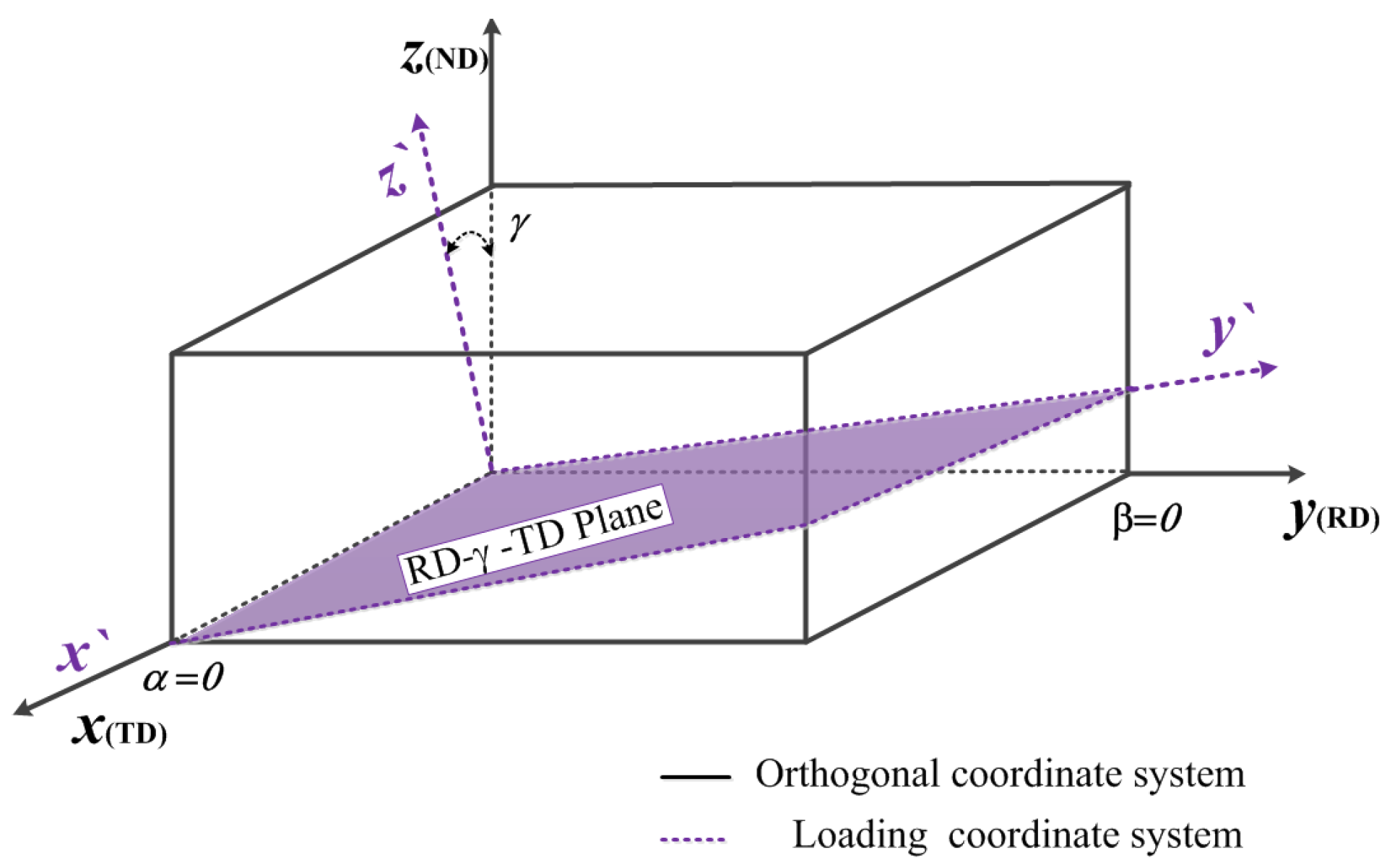
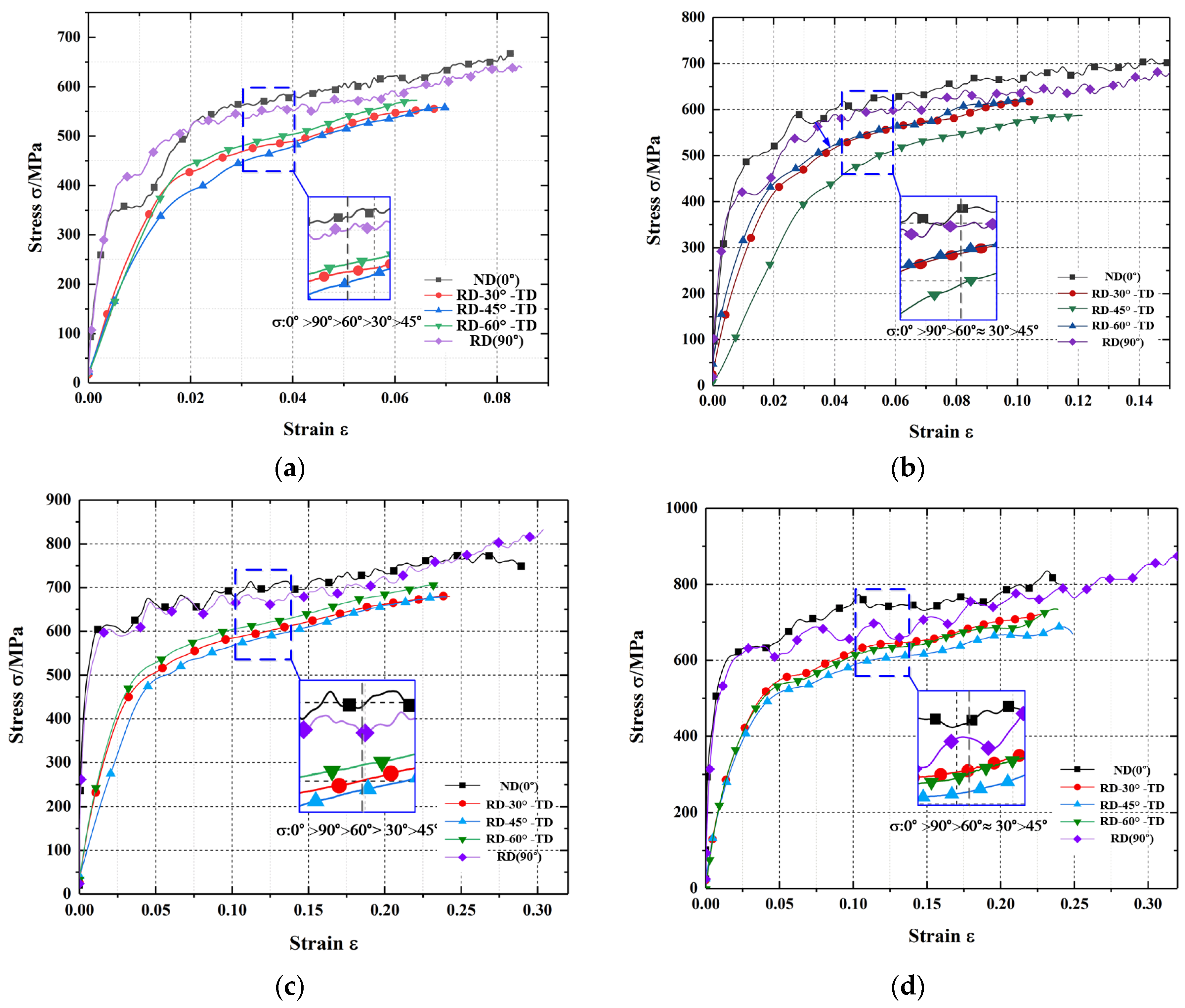

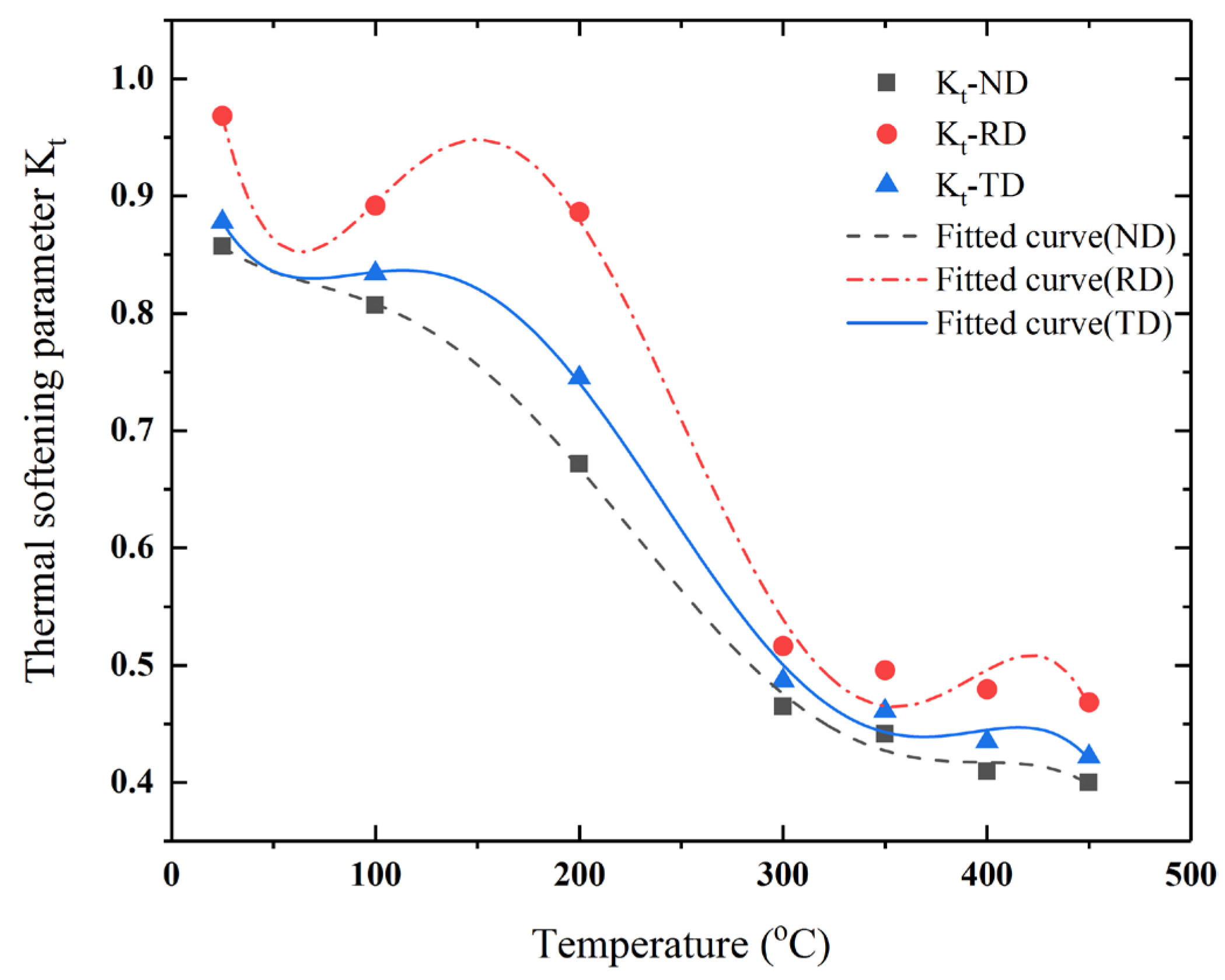
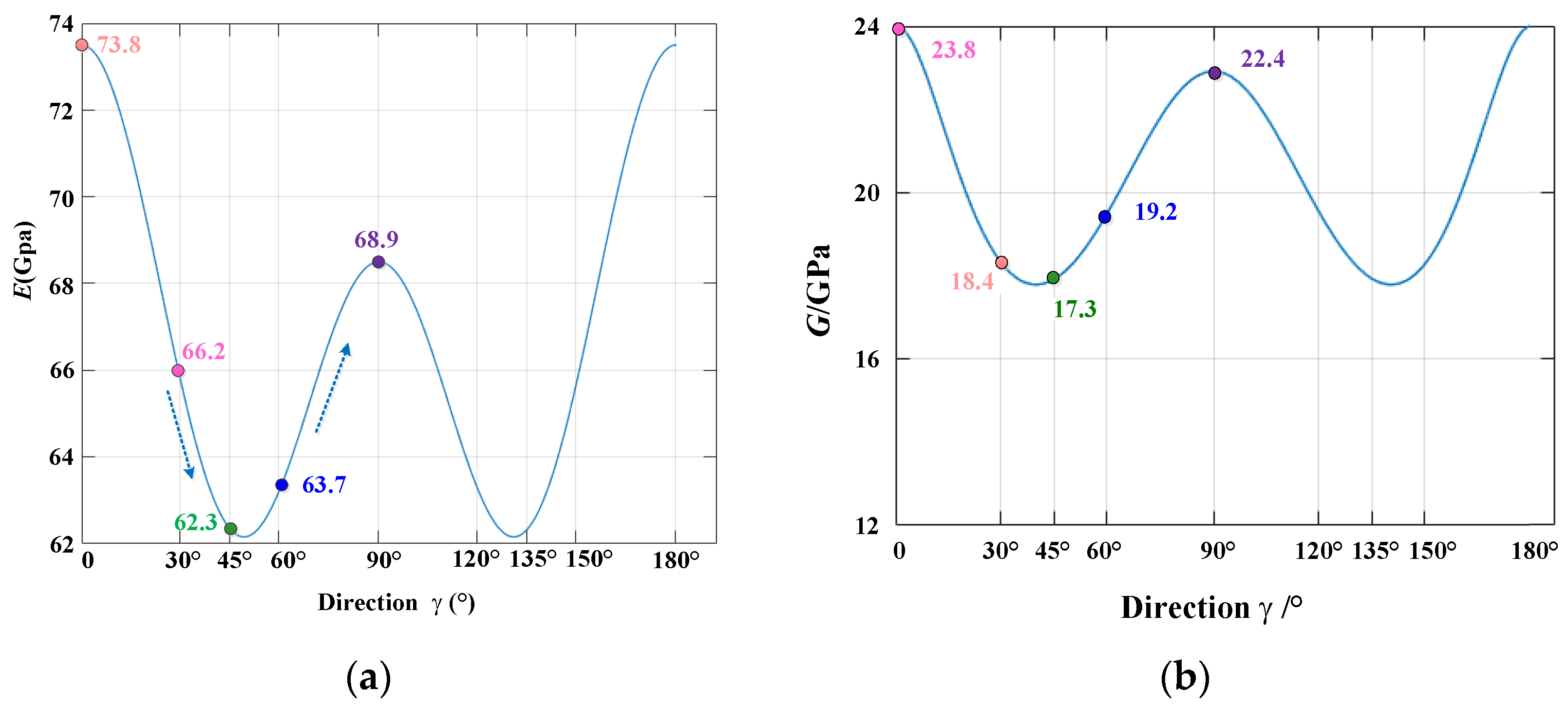
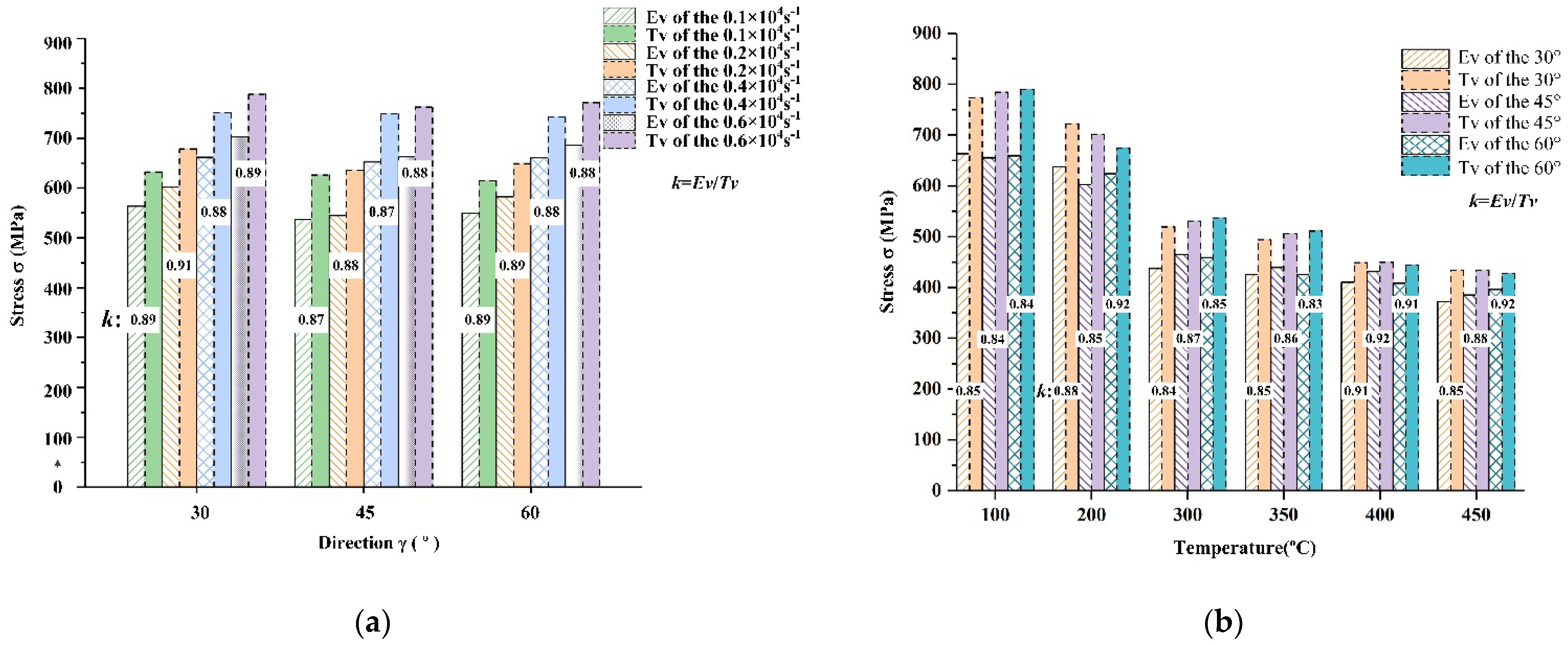
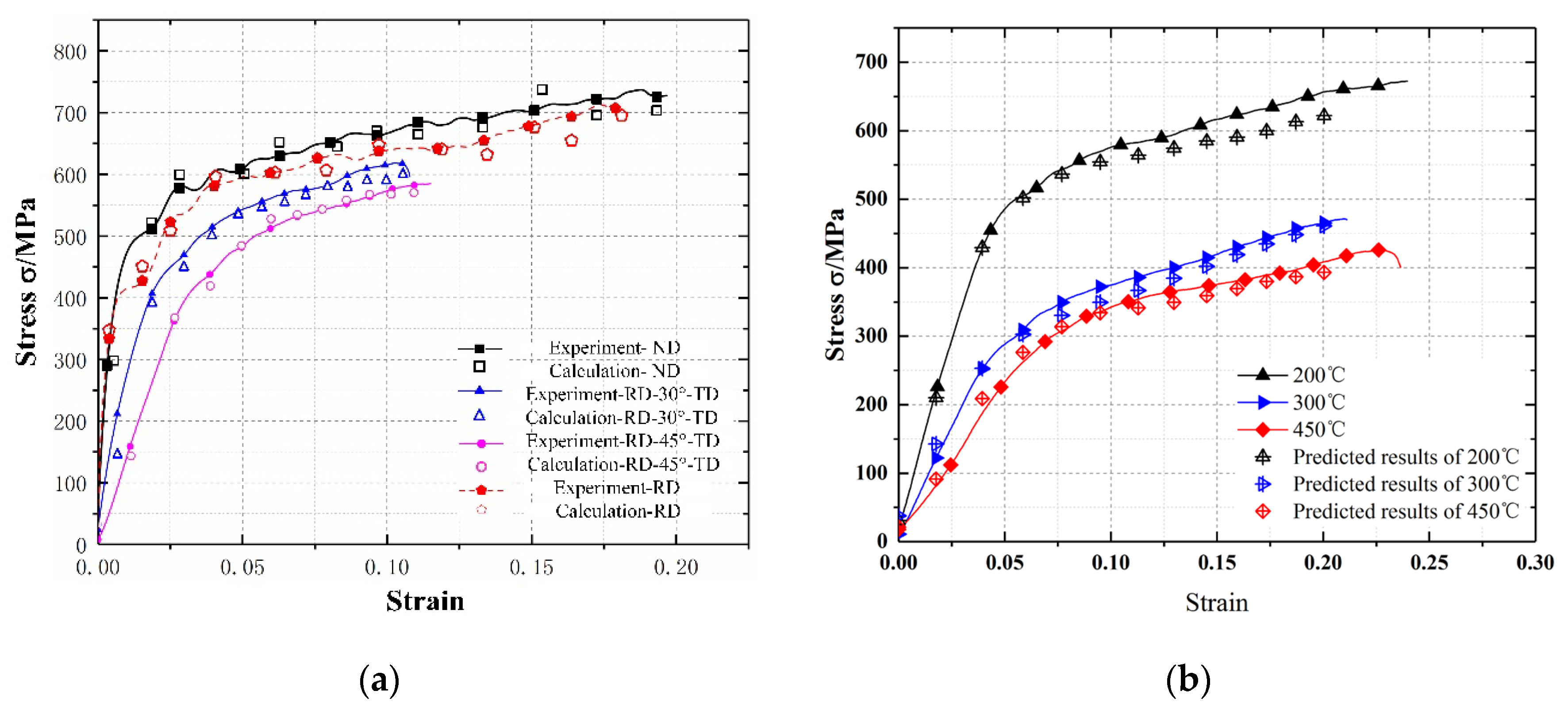
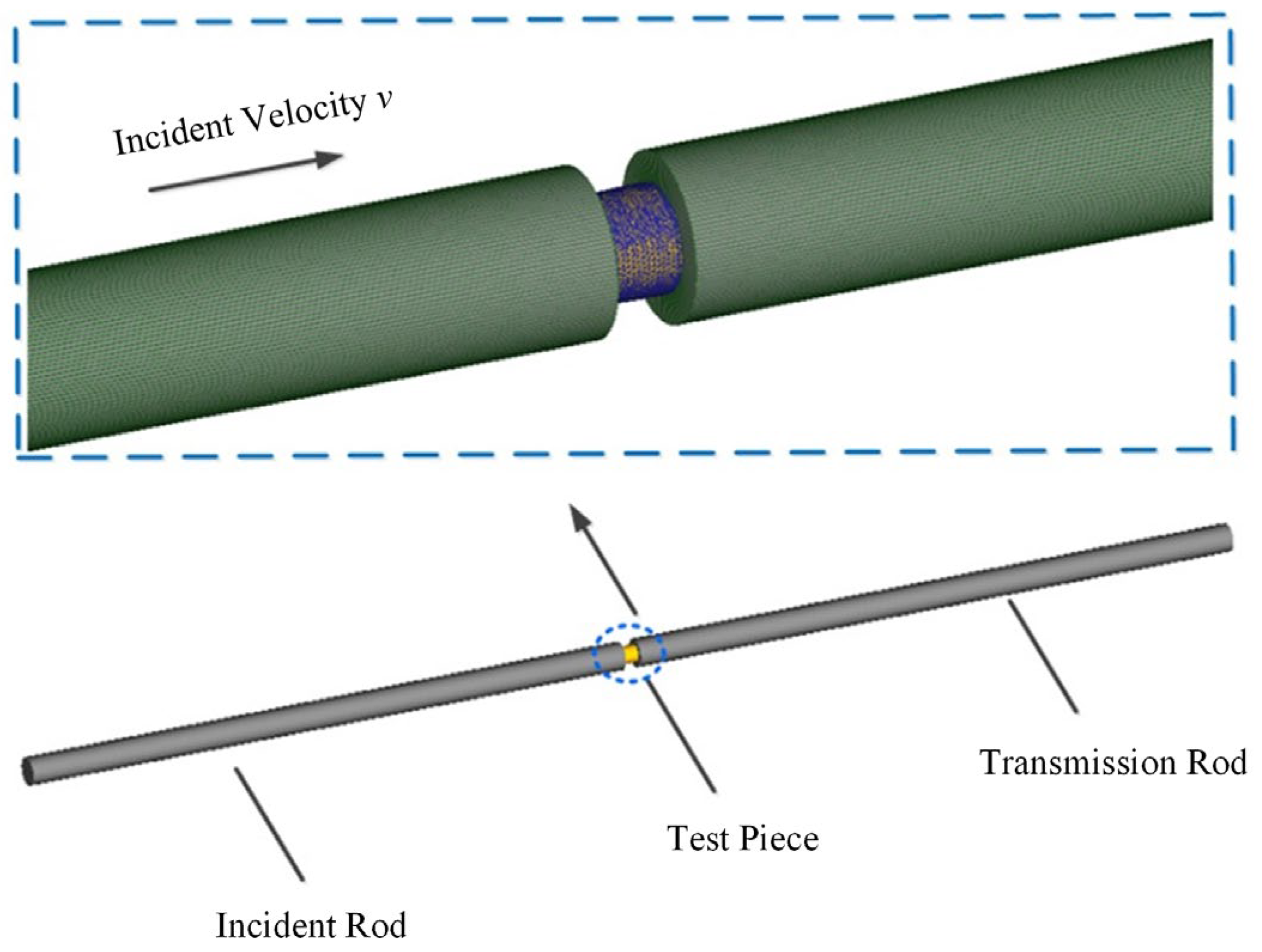
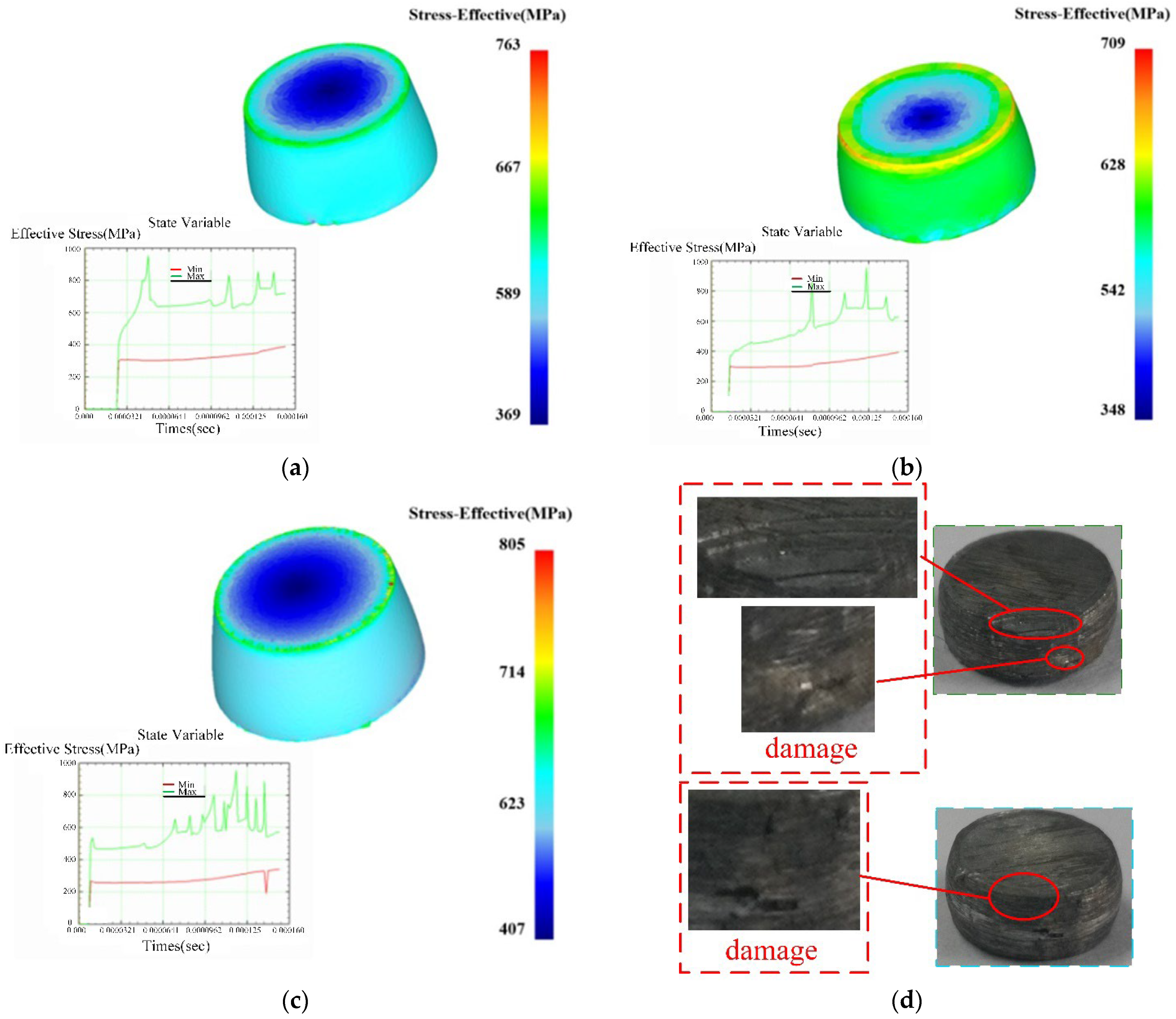
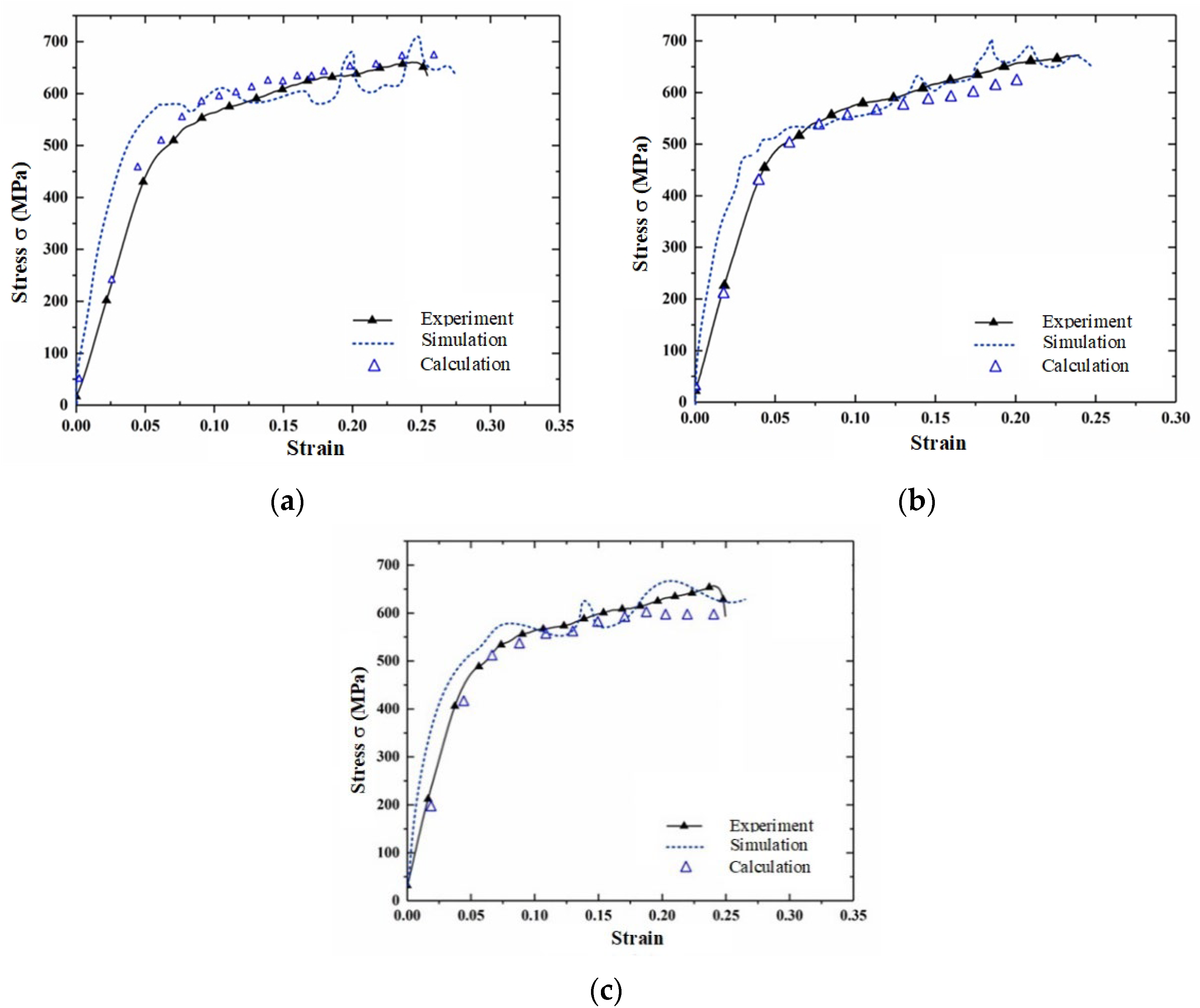
| Forming Directions | A (MPa) | B (MPa) | C | n |
|---|---|---|---|---|
| ND | 365 | 516 | 0.042 | 0.26 |
| TD | 357 | 490 | 0.04 | 0.3 |
| RD | 342 | 452 | 0.029 | 0.26 |
Publisher’s Note: MDPI stays neutral with regard to jurisdictional claims in published maps and institutional affiliations. |
© 2022 by the authors. Licensee MDPI, Basel, Switzerland. This article is an open access article distributed under the terms and conditions of the Creative Commons Attribution (CC BY) license (https://creativecommons.org/licenses/by/4.0/).
Share and Cite
Wang, Z.; Fu, X.; Xu, N.; Pan, Y.; Zhang, Y. Spatial Constitutive Modeling of AA7050-T7451 with Anisotropic Stress Transformation. Materials 2022, 15, 5998. https://doi.org/10.3390/ma15175998
Wang Z, Fu X, Xu N, Pan Y, Zhang Y. Spatial Constitutive Modeling of AA7050-T7451 with Anisotropic Stress Transformation. Materials. 2022; 15(17):5998. https://doi.org/10.3390/ma15175998
Chicago/Turabian StyleWang, Zhenda, Xiuli Fu, Nianwei Xu, Yongzhi Pan, and Yijia Zhang. 2022. "Spatial Constitutive Modeling of AA7050-T7451 with Anisotropic Stress Transformation" Materials 15, no. 17: 5998. https://doi.org/10.3390/ma15175998
APA StyleWang, Z., Fu, X., Xu, N., Pan, Y., & Zhang, Y. (2022). Spatial Constitutive Modeling of AA7050-T7451 with Anisotropic Stress Transformation. Materials, 15(17), 5998. https://doi.org/10.3390/ma15175998






